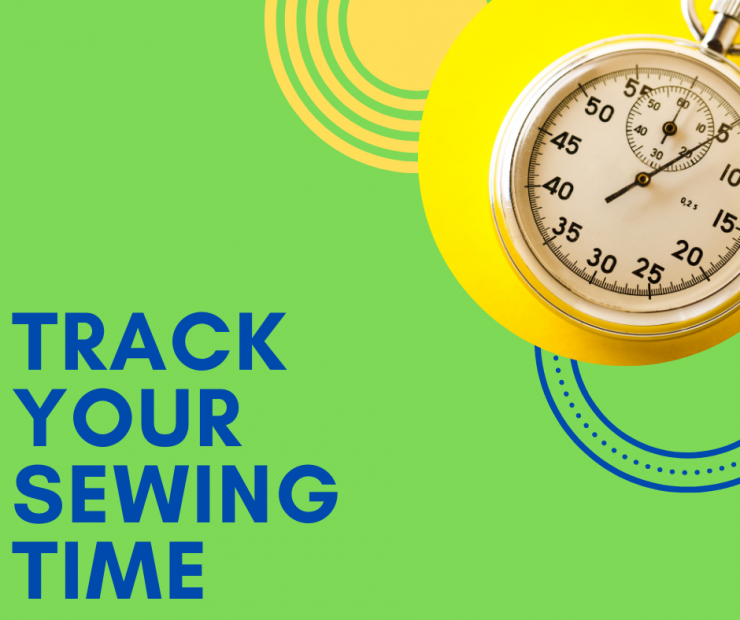
My first introduction to time tracking came from Laura Vanderkam; author, podcaster and all-around time management champ. She advocates that the simple act of tracking how you spend your time is the first step to understanding where all of your time goes and learning how to get lost time back.
For us quilters and sewists, time tracking can be the first step towards solving many of of our sewing problems! When we know how we spend our time, we can make better decisions in what to do in any particular moment. It is a visual representation of what we chose to prioritize in any given week, even if we didn’t realize we were making those prioritization decisions.
How to Track Your Time
Tracking your time can be as simple or as complex as you want it to be. Here are a few ideas, ranging from simplest to more complex:
- Before bed, think back over your day and write down the basic activities you did, and what time you did them.
- Using a planner with times, write down activities as you do them throughout the day. Use as much or little detail as you’d like.
- Make a voice memo on your phone and add to it throughout the day as you do things. Keep it short and sweet with notes such as “1:00-2:00 faculty meeting with focus on next semesters curriculum”.
- Print out a time tracking sheet (Laura Vanderkam provides a free one here) and fill it in each day for at least one week.
- Use an online time tracker, such as Toggl. Many time trackers also have an app, so you can update your time log at your desk or on the go.
Use Your New Time Knowledge
Now that you know where your time goes, it’s time to start thinking about how you can use it better. What you discover about your time is going to vary greatly depending on your day-to-day life; a college professor will have different time challenges than a waitress.
Look beyond the details of “what” you did and see if you can identify some of these common trends in your own time tracking data! (Truth alert: I’m guilty of SO many of these! )
- You spend WAY more time on your phone than you realized. This includes every time you pick up your phone to check a text, scroll on social media, play a game or check the news.
- You run out of energy at the time time every day, and spend that time watching Netflix or Hulu instead of working on your hobbies (like quilting!)
- You’re getting less sleep that you thought.
- You spend a lot of time waiting for the next thing, whether it’s dropping off the kid in the carpool line, waiting during a music lesson, or sitting in traffic on your daily commute.
- You have lots of little pockets of time that you’re not using intentionally; 15 minutes here and there throughout the day.
The next step is to brainstorm ways upgrade your time! For whatever time issues you have uncovered, what changes can you make?
- Can you make a kit for hand sewing projects that you take when you know you’ll be waiting during a lesson or rehearsal?
- Can you declare that that weird 15 minute block when it’s just a little bit too early to start dinner as time to head into your sewing studio and chain piece blocks for your current project?
- Can you set an alarm on your phone for 30 minutes before bedtime so that you have time to wind down and get a better night’s sleep? (Remember, sleep is SO important, even for sewing! Mom always told me to “never cut fabric when you’re tired.”
- Can set up your sewing space so you can sew and watch a movie at the same time? (This can be especially nice when you’re rewatching a show, so you don’t have to look at the screen as often).
- Can you listen to a quilting, crafting or sewing podcast during your rush hour commute?
Learn your Quilting Time Math
Time tracking can help reveal something slightly nerdy but super rewarding: knowing how long it takes you to do certain quilting or sewing tasks. We can learn how long it takes us to do certain repetitive tasks, and then use basic math skills to determine how long a quilt might take.
If you know it takes you 20 minutes to make a Bear Paw quilt block, and you need 36 for your quilt, then you know that you’ll need at least 12 hours for block production alone, plus additional time for things like sashing and borders. This can help you plan better as well as temper expectations (your and those of others).
Action Steps
Ready to give time tracking a try? Pick one of the methods from the first section above and give it a whirl! Track time for at least a week, then review to see where you can make better use of your time for sewing!


Leave a Reply